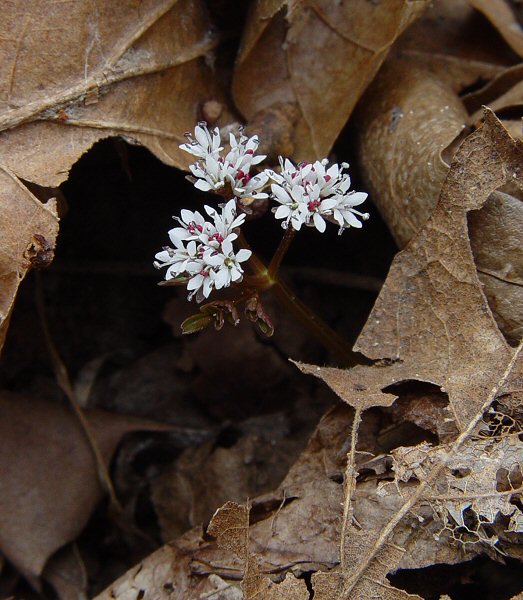Erigenia bulbosa (Michx.) Nutt.
Harbinger Of Spring

Native
CC = 6
CW = 5
MOC = 50
© SRTurner
Erigenia bulbosa (Michx.) Nutt.Harbinger Of Spring | |
 |
Native CC = 6 CW = 5 MOC = 50 |
© SRTurner |
|
Family - Apiaceae Habit - Perennial forb with globose tubers.
Stems - To 15 cm tall, weakly ascending to erect, single or multiple from the base, fleshy, purplish or green, glabrous, angled to ribbed.
Leaves - Mostly basal, petiolate with sheathing bases, ternately decompound, glabrous. Petioles grooved adaxially, purple, to 2 cm long. Leaves to 5 cm broad and long. Ultimate divisions of the leaves acute, entire, shiny below, dull green above, the tips with a minute translucent spot (use a lens to see), with a single midrib. Uppermost leaf of the stem reduced and bract-like.
Inflorescence - Terminal, simple or more commonly compound umbels, sessile, usually produced as leaves are forming. Primary rays 1-4, 0.6-1.5 cm long, glabrous, purplish. Involucre of 1 leaflike bract. Umbellets subtended by involucel of 3-7 bractlets, these about 5 mm long, longer than the flower stalks. Umbellets with about 6 flowers. Pedicels purple, glabrous, to 1.5 mm long.
Flowers - Petals 5, white, glabrous, oblanceolate to spatulate, to 4 mm long, 1 mm broad, spreading. Stamens 5, erect. Filaments white, glabrous, 2-2.2 mm long, thicker at the base. Anthers pink to wine-colored when fresh, becoming black when dry. Pollen white. Styles 2, glabrous, pinkish, expanded and deep purple at the base. Ovary inferior, 2-locular, one ovule per locule. Calyx purple, glabrous, 1-1.1 mm tall, 1.4 mm broad, ribbed, slightly thickened at the apex. Sepals absent.
Fruits - Schizocarps 2-3 mm long, depressed-circular in outline, sometimes shallowly cordate at the base, shallowly and narrowly notched at the tip, strongly flattened laterally, glabrous, dark brown, each mericarp strongly curved at maturity, with 5 thin ribs sometimes narrowly winged, the commissures corky-thickened.
Flowering - January - April. Habitat - Rich shaded woods, at or near the base of slopes, alluvial soils along streams and in valleys, alluvial thickets, at the base of rocky bluffs. Origin - Native to the U.S. Lookalikes - None close. Other info. - This minute species is the first native wildflower to bloom in Missouri. Because of its small size and camouflaging habitat, it is often overlooked. The flowers rarely protrude more than one or two centimeters above the forest leaf litter. The pinkish anthers quickly dry and turn black. The black of the anthers and the white of the petals give the plant a "pepper and salt" appearance. The inflorescences are produced first, with the leaves of the plant unfolding completely near the end of the plant's growing season. By the warm months of late spring, the plant is dried and gone. The species is found in the eastern 2/3 of the state. Missouri lies near the western edge of its U.S. range, which extends into western Pennsylvania through northern Alabama. Photographs taken at Eagle Bluffs Conservation Area, Boone County, MO., 3-13-04 (DETenaglia); also at Shaw Nature Reserve, Franklin County, MO, 3-22-2019, 4-3-2019, and 3-26-2020, and at St. Francois State Park, St. Francois County, MO, 3-10-2025 (SRTurner). |